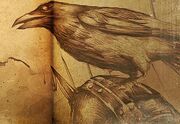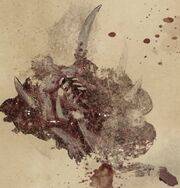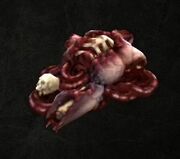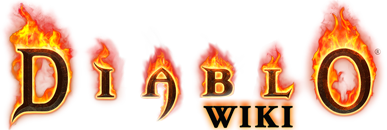
A raven, a bird associated with death in Sanctuary
Death is the cessation of life for a being.
Lore[]

The results of a violent death
Early nephalem were unaware of death, at least in as much as it applied to themselves. Gratian was the first of their number to be slain, followed closely by Bersarik. Even as the nephalem grew in number, many more were found by death, as it spread across the world.[1]
The spirits of humans who have died have sometimes described death in different ways. Isendra likened her moment of death as being akin to a bowstring—as she died, she found herself being stretched over all of Sanctuary. Yet the 'string' was drawn back, and her spirit wound up in the Pandemonium Fortress. The Guardian stated that it was impossible to describe death to one who was still living. When pressed, he asked whether someone could describe their own birth. A Master Crusader described death as "the coldest night on the plains, with a warm fire at your feet. The Crusader told their former apprentice that when they died, they would know whether death was the fire or the night, and that they had known what death was all along.[2]
Malthael, former Archangel of Wisdom, embodied death as the Angel of Death.[3] The Nephalem in turn became one with death.[4]
Lord Death is the supposed personification of death in at least one of Sanctuary's cultures.[5] Legends say that ravens serve as his couriers, carrying souls to the afterlife.[6] There is a popular belief in Sanctuary that wearing the feathers of carrion birds delays death for a year.[7] Ku Y'leh became famous for his studies of life beyond death, though Ormus maintained that "there is no life beyond death. There is only life."[8] Deckard Cain once wrote of the "veil of death," of being a place where the departed passed beyond.[9]
It is from death itself that necromancy gains its power.[10] The corpses of those who died a violent death contain the anguish of the corpse's final moments. Through spellcraft, a Necromancer can call upon these energies and focus them into a single violent force. This force then expels itself from the carcass with such power that it causes a dramatic explosion.[11]
Some corpse body parts are venerated, such as teeth, fingers, and femurs.[12]
Gameplay[]
Diablo I[]
In Diablo I, death ends the game, and the player is forced to restart from their last save.
In the game's Multiplayer death would cause the player to drop all their carried items at that spot.
Multiplayer also has a Resurrect Spell which another character can use to revive the deceased, or the fallen character could respawn in town with reduced Health and Mana.
Monsters who die in the game die permanently and do not respawn (unless resurrected by some other monsters). Hence, the game's number of enemies are finite.
Diablo II[]
In Diablo II, the player is revived without any equipped items or minions, in the act's town. To regain their lost items, the character has to return to the place they died, and pick up their 'corpse' - often a dangerous proposition, as any monsters in the area remain. Further deaths (even of an itemless character) result in more corpses. A corpse will appear in town only if the player restarts their game, but only the most recent corpse would appear - thus, if a character died multiple times, they might lose all items they had equipped.
In the Hardcore mode of Diablo II, death is permanent, and a deceased player can no longer create or join games.
If a monster dies, it leaves behind a corpse on the ground. In Diablo II, the corpse has several possible functions:
- Revival by a Necromancer, as a minion, or exploding the corpse to damage nearby foes.
- Looting, by a Barbarian via Find Potion and later Find Item. These abilities allows a Barbarian to find 'hidden' potions and items beyond initial item drops.
- Creation of a Grim Totem, by a Barbarian, using the Grim Ward skill. These totems cause nearby monsters to flee, but vanish after a set time period.
- Conversion into life or mana by the Druid and Paladin. The Druid uses the Carrion Vine or Solar Creeper to do so; only life or mana can be converted at one time. Paladins use an aura skill called Redemption which works similarly.
Corpse Spitters could consume corpses as means of generating projectile attacks.
Some monsters are able to revive their allies. For instance, Fallen Shamans are able to revive fellow Fallen. Some bosses, such as Radament, are also able to revive minions.
Monsters often drop items upon death; this is one of the main methods of item collection. Some bosses drop more powerful items, whether randomly spawned items (such as 'rare' or 'set' items in Diablo II), or specific, pre-determined items (such as the Book of Skill dropped by Radament).
Some monsters may also cause effects upon death. For instance, Embalmed and similar monsters release a cloud of poison when they die. The most drastic of these are caused by bosses - for instance, the death of Blood Raven killed any Hungry Dead she had summoned. Some monsters may even revive upon death, like the Returned in the game's fifth act.
Diablo III[]
In Diablo III, player death wears down the player's equipment, damaging its durability by 10% (from level 10 and upwards). The equipment is kept when respawning in town. There exist no corpse runs, unlike Diablo II. Due to the physics system introduced, if Blizzard had implemented Diablo II's method of corpse retrieval, it would have frustrated many players. If one cannot get one's equipment back easily, it might resemble forcing something approaching Hardcore mode on players who may not feel up to the challenge.
Once a Softcore character is dead, they have four options:
- Revive at last active checkpoint (note that some teleports to town count as setting new checkpoint)
- Revive at corpse (must wait 5 seconds), cannot be used in boss fights, and can only be done 3 times in a row (reset when changing zone, spending over 5 minutes not dying, or venturing too far from the previous death site)
- Revive in town
- Players can also be revived by other players, who must click on their grave markers and channel it for 3 seconds without taking damage.
Reviving at corpse or checkpoints will place hero in a 'phased out' state, in which they are immune to damage, cannot perform any actions other than movement and picking up Gold, are invisible and may move through enemies unhindered. Their followers, however, are vulnerable as normal during that time (and may distract monsters from the character, buying them time to recover and rebuff).
In Greater Rifts, players may not revive in town; only at corpse (with timer increasing from 5 to 30 seconds with each death) or at last checkpoint.
Death imposes no penalty on the player aside from item damage (unless the item is indestructible) and losing the Pool of Reflection experience buff, as well as any other buffs (and nearly all debuffs). However, death does not stop (and does not reset) any ongoing cooldowns (with exception of those applied as debuffs, which are removed normally).
Monsters do not have permanent death and will respawn each time a game is loaded (akin to Diablo II).
Hardcore mode Heroes who die, of course, cannot be brought back from the dead. However, upon such circumstances, the player can elect to place that hero in a special Hall of Fallen Heroes, for other players to see. Customer Support will not revive dead Hardcore characters, even if death came on fault of anyone other than the owner: according to EULA, by starting a Hardcore game, the player agrees on the terms that they and they alone are responsible for their character's death.
For monsters, death is not always permanent even for the duration of the game: some of them may revive their fallen allies. To prevent this, one must kill them with Critical Hits, which destroy their corpses irreversibly. Some abilities, like Disintegrate or Soul Harvest, have a Slain Enemies Rest in Pieces trait, but it is a purely cosmetic effect: if there are resurrectors nearby, only a Critical Hit may lay the monster to permanent rest.
There are abilities and effects in game that save the character from dying (usually with a considerable cooldown). These effects trigger only when all other methods of absorbing or otherwise evading fatal damage were used up:
- Unstable Anomaly, Firebird's Finery Set (Wizard)
- Awareness, Beckon Sail (Demon Hunter)
- Spirit Vessel (Witch Doctor)
- Near Death Experience (Monk)
- Indestructible, Prophet (Crusader)
- Nerves of Steel (Barbarian)
- Final Service, Self Sacrifice (Necromancer)
- Ancestors' Grace (All Classes, Hardcore only)
- Pauldrons of the Skeleton King (All Classes)
- Fate's Lapse, Guardian, Vanish (All Classes - Follower ability)
Necromancer Corpses[]

Necromancers use monster corpses as a secondary resource for skills, such as detonating them with Corpse Explosion, raising them with Revive, consuming them with Devour or creating deadly projectiles from them with Corpse Lance.
Only Necromancers can see these corpses, and this resource is unaffected by abilities that normally destroy corpses, so the Necromancers do not leave themselves without fresh bodies with attacks, nor do their allies.

Concept art
These corpses have alternate graphics (see picture) and appear at the site of every slain monster. In multiplayer, each Necromancer sees their own corpses, and cannot affect those of other Necromancers in the party.
The copses remain behind nearly all monsters, even those that explode on death (Grotesques, for instance) or are not made of organic matter (such as Sand Golems). The only enemies leaving no usable corpses are stationary towers, traps and similar constructs, as they are considered more of objects rather than creatures.
Certain skill runes can generate corpses for later use, so even without any supplemental monsters around, a Necromancer can still use their corpse skills, though to lesser effect. Land of the Dead skill is specifically designed to give a short period of unlimited corpse-consuming skill use.
A maximum limit of 15 corpses can remain available for a necromancer to consume at any one time. If new corpses are created once this limit has been reached, old corpses will disappear and become unavailable for use as they are replaced by new ones being created. The only exception to this limit is when using Land of the Dead, which will not cause any existing corpses to disappear (since it does not actually create any new corpses, only treats any ability as if it had 10 of them per cast).
The game's code had to be rewritten for the inclusion of corpses as a resource, as monsters can often go flying away after death, and some monsters are too large to generate reasonably sized corpses.[13]
Diablo IV[]

A pile of Fallen corpses
In Diablo IV, when the player dies, their ghost hovers above their corpse for a few seconds before release.[14]
Cheat death abilities return in form of Undying Rage.
Trivia[]
- Certain lines in The Gospel of Death, if taken literally, indicate that death has metaphysical qualities within the setting. In light of Bersarik's death, it is written "death had found Sanctuary, and could not be stopped," while the death of Gratian is treated as a watershed moment for the nephalem, given his status as the first nephalem to perish.
References[]
- ↑ The Gospel of Death
- ↑ Diablo III, Act V, Angel of Death
- ↑ Reaper of Souls, Blizzard Entertainment. Accessed on 2013-08-22
- ↑ Diablo III, Act V
- ↑ Legacy of Blood
- ↑ Diablo III, The Raven's Wing
- ↑ Diablo Immortal,Winged Darkness
- ↑ Diablo II, The Infernal Gate, The Golden Bird
- ↑ Diablo III, Mirrorball
- ↑ 2016-11-04, Restoring the Balance—Necromancer Overview. Blizzard Entertainment, accessed on 2016-11-07
- ↑ Diablo II Manual
- ↑ Book of Lorath
- ↑ 2017-06-30, Behind The Necromancer. YouTube, accessed on 2017-07-03
- ↑ 2019-11-02, BlizzCon 2019: Diablo IV Gameplay Videos by Livestreamers. Blizzplanet, accessed on 2019-11-20
